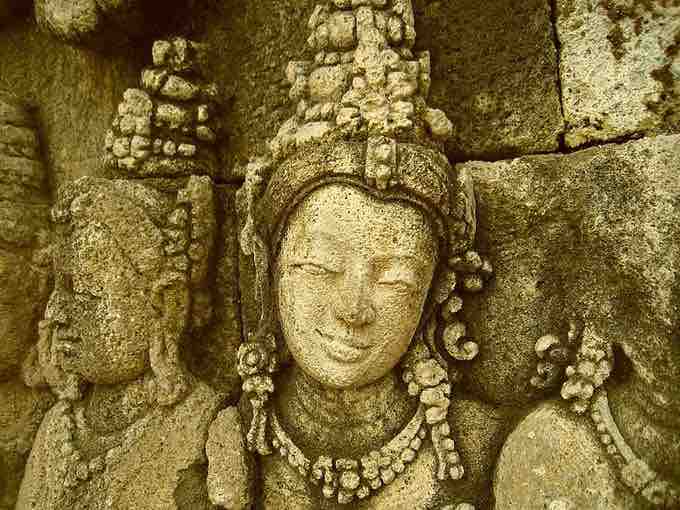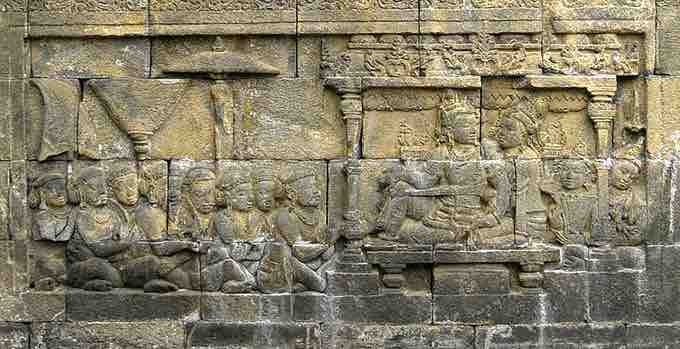Overview: Relief Sculpture
Relief is a sculptural technique which gives the impression that the sculpted material has been raised above the background plane. This is accomplished by cutting into a flat surface of stone or wood, thereby lowering the field and leaving the unsculpted parts seemingly raised. Reliefs depicting figures that are at least life-size or bigger or are attached to monuments of some sort are termed monumental reliefs by art historians, thus distinguishing them from small metal or ivory reliefs, portable sculptures, and diptychs.
Monumental Reliefs in Southeast Asia
Monumental reliefs represent an important facet of ancient Southeast Asian art, where sculpture and architecture were intimately connected with one another. As a result, relief sculpture was generally used to decorate the walls of buildings—particularly Hindu and Buddhist temples—and was accomplished on a very large scale. It was greatly influenced by Indian styles and techniques, and it generally portrayed religious themes with high iconographic precision. Court and battle scenes, scenes depicting daily life and the customs of the people, and animals (both real and mythical) were other common subjects. Most of ancient Southeast Asian relief sculpture was done in bas-relief, where the projecting images have shallow overall depth, although the kingdom of Champa in southern and central Vietnam excelled in haut-relief sculpture, which was marked by much greater depth and undercut areas.
Notable examples of monumental reliefs include Borobodur in Java, Angkor Wat in Cambodia, the Sanchi case in India, and many South Indian temples, including the Unakoti group of sculptures at Kailashahar, Tripura, India.
Borobudur
The most famous examples of monumental relief sculptures in Southeast Asia are to be found in the 9th-century Buddhist temple of Borobudur in Java, Indonesia. Built during the rein of the Indic Sailendra Dynasty, the temple is constructed to reveal many different levels of terraces, many of which are heavily ornamented with intricate bas-reliefs. In total, there are 2,672 individual bas-reliefs, 1,460 of which depict narratives from Buddhist lore, including the birth and life of the Buddha. The remaining 1,212 are solely decorative.

Lalitavistara Deva listening to Dhamma
Detail of carved relief from Borobudur, depicting a figure from the Buddhist pantheon.
Khmer Temples
The Khmer of Cambodia were also renowned for their monumental bas-reliefs, which usually took narrative form, depicting stories from history and mythology. They decorated the tympana (semi-circular arched spaces above a doorway), walls, and ceilings with complex scenes. The earliest surviving example of Khmer narrative bas-relief sculpture comes from the 10th-century Hindu temple of Banteay Srei, which has carved tympana and towers depicting scenes from the great Hindu epics, the Ramayana and the Mahabharata. The most famous example of Khmer bas-relief sculpture is undoubtedly at the 12th-century Hindu temple of Angkor Wat, which has 13,000 square meters of narrative bas-reliefs on the walls of its outer gallery.

The Churning of the Sea of Milk, Angkor Wat
This episode from Hindu mythology is depicted in bas-relief on the south of the east wall of Angkor Wat's third enclosure.
Themes
The reliefs have a diverse range of themes. They depict mythical, spiritual beings from the Buddhist pantheon such as bodhisattvas, apsaras (celestial dancers or musicians), gandharvas (male nature spirits), and asuras (demons). They also depict images of people, such as the king and queen, princes, priests, courtiers, soldiers, servants, and commoners. Many of these reliefs provide glimpses of scenes of daily life; for example, the relief sculptures from Borobudur depict scenes from 8th-century Java, including courtly palace life, a hermit in the forest, commoners in the village, temple and marketplace scenes, native vernacular architecture, and flora and fauna. These bas-relief sculptures have served as a reference for historians in the study of ancient Javanese architecture, weaponry, fashion, and transportation.

King and Queen with their subjects
The bas relief of 8th century Borobudur depicted the palace scene of King and Queen accompanied by their subjects. It is strongly suggested that the relief depicted the actual scene of Sailendran royal court.
In addition, a group of 160 panels of monumental relief sculpture provides a complete illustration of the law of karma or the principles of cause and effect. There are depictions of both praiseworthy activities (including charity and pilgrimage) and blameworthy activities (ranging from gossip to murder), with their corresponding rewards and punishments. These panels provide particularly complex scenes of daily life, depicting the full panorama of samsara (the endless cycle of birth and death).